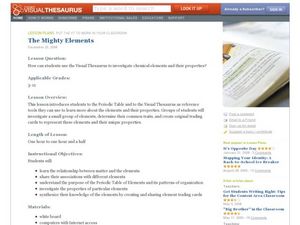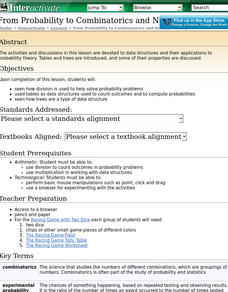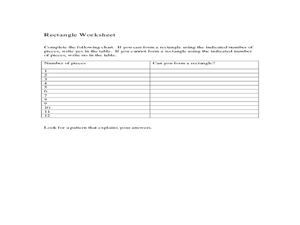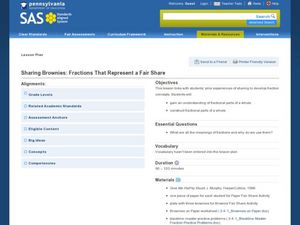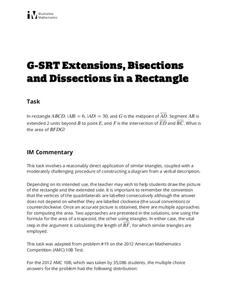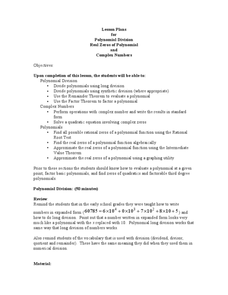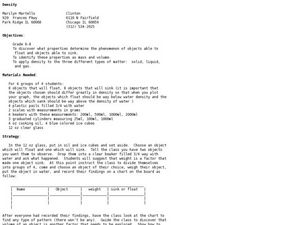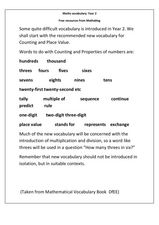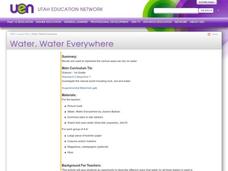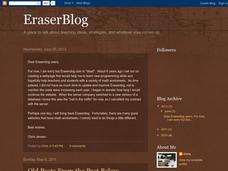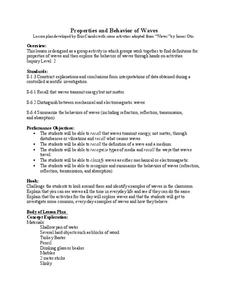Curated OER
The Mighty Elements: Using the Visual Thesaurus to Investigate Chemical Elements
Pupils create trading cards for elements in the Periodic Table. Initially, they are introduced to the Periodic Table of Elements and the concept of elements in the world around us. After dividing into groups, learners use the Visual...
Shodor Education Foundation
From Probability to Combinatorics and Number Theory
What middle schooler does not enjoy an occasional online game? In this lesson play, you will find embedded links to an online probability game, and informative pages about how division is used in probability, the concept of tree models,...
Curated OER
Area, Perimeter and Rations Using Pentominoes
Learners of all ages investigate area and perimeter through pentominoes. In this geometry activity, students calculate the are and perimeter of different geometric shapes and describe the properties of similar and congruent shapes. This...
Curated OER
The Worldly Philosophers by Robert Louis Heilbroner
CliffsNotes provides a list of study questions to help your high schoolers grapple with The Worldly Philosophers. Some of them are simple and straight forward, while others offer an opportunity to dig in deeper! Consider printing this...
University of Colorado
Looking Inside Planets
Researchers use scientific data to understand what is inside each of the planets. The first in a series of six, this lesson builds off of that concept by having pupils use a data table to create their own scale models of the interiors of...
Utah Education Network (UEN)
Finding Missing Lengths of Similar Triangles
Middle and high schoolers explore the properties of similar triangles. In this geometry lesson, pupils play a similarity basketball game, sketch similar triangles, and find the missing measures of similar figures. They find the height of...
Curated OER
Matrix Madness!!
Perform operations to add, subtract, multiply and divide matrices. Then solve problems with vectors using matrices. A three day lesson: Matrix Madness, Mystical Matrices, and Decode the Encode. The last lesson has prizes that the class...
Curated OER
Sharing Brownies: Fractions That Represent a Fair Share
Elementary graders discover the concept of fractional pieces of a whole. They investigate the meanings of fractions in everyday life and why they are used. Pupils divide brownies amongst each other to demonstrate the use of fractions...
Illustrative Mathematics
Extensions, Bisections and Dissections in a Rectangle
Gaining practice in translating a verbal description into a diagram and then an equation is the real point of this similar triangles exercise. Once the diagram is drawn, multiple methods are provided to reach the conclusion. An effective...
Education Development Center
Making Sense of Unusual Results
Collaboration is the key for this equation-solving lesson. Learners solve a multi-step linear equation that requires using the distributive property. Within collaborative groups, scholars discuss multiple methods and troubleshoot mistakes.
Curated OER
Density of Glass Fragments
Students explore how the density of an object is determined and determine what a "physical property" is. They demonstrate how science can be applied to police work.
Curated OER
Polynomial Divisions
Students factor polynomials and use long division t solve problems. In this algebra lesson, students find the zeros of polynomials by synthetic and long division. They perform operation using complex numbers.
Curated OER
Density: Float or Sink
Students discover density. In this density lesson, students discover the properties of objects that allow them to float or sink in water.
Curated OER
Motions and Forces
Sixth graders investigate the construction of a magnet and the force it produces. They identify various materials as magnetic or non-magnetic, discuss the properties of magnetic properties, and conduct an experiment with a compass and...
Curated OER
Math Vocabulary: Year 2
In this math vocabulary worksheet, students study words that are associated with number properties, counting, and place value. They see number words that will be used in the context of lessons such as how to multiply.
Curated OER
Water, Water Everywhere
First graders study water-its properties, its 3 states, and the way we rely on it for everyday living. They read Water, Water Everywhere, draw murals of where they have seen water and the ways they use it and eat/drink snacks that are...
Curated OER
Solving Inequalities
In this solving inequalities learning exercise, 9th graders solve 15 different inequalities. First, they use the addition, subtraction, multiplication, and division properties of inequalities to solve linear inequalities. Then, students...
Curated OER
Algebra Review
For this algebra review worksheet, 9th graders solve and complete 12 different problems. First, they use addition, subtraction, multiplication, and division properties of inequalities to solve the linear inequalities. They also write...
Curated OER
Evaluating Formulas
For this evaluating formulas worksheet, 9th graders solve 10 different problems related to various types of formulas used in evaluating equations. First, they determine the value of the indicated variable. Then, students substitute each...
Curated OER
Properties of the Ocean: Change
Students research and create a visual presentation on the seasonal salinity of the Earth's oceans. They apply the research in a simulation of a lab disaster in which they must relabel ocean samples.
Curated OER
Properties of Light
In this light spectrum worksheet, students will read a diagram and a chart listing information about the different types of light rays from Gamma rays to radio waves. Then students will write a short essay about a new life-form that...
Curated OER
Long Division in Two Digits
In this math worksheet, learners find the solutions to the problems for long division. The answers can be shown in the printable version.
Curated OER
Properties and Behavior of Waves
High schoolers explore the different properties of waves. In this physics lesson, students differentiate mechanical and electromagnetic waves. They explore each lab station and write their observation about the wave behavior they see.
